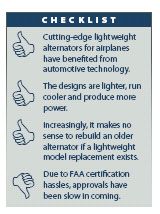Alth
Innovative suppliers have responded to the frustration of premature vacuum pump failure with new designs and backup strategies to include electric attitude gyros. Now, alternators are getting some attention. At Oshkosh in recent years, weve noticed a profusion of new alternator designs that are lighter, smarter and more efficient than the automotive adaptations found on the typical Lycoming or Continental engine. Unfortunately, while improved starters have found their way into the certified market-see
Aviation Consumer August 2006 for a report-new tech alternators have been largely limited to the Experimental segment.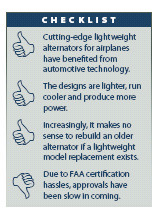
This year, thats beginning to change. At least four companies are migrating what used to be Experimental-only products into the certified arena and more may be on the way. As with lightweight starters, these new alternators are lighter and use improved materials and designs in the hopes of offering better efficiency and reliability. Moreover, these new alternators develop cleaner, less electrically noisy power, which is a must for aircraft that are increasingly equipped with all-electronic instrumentation. Heres a survey of whats on the market.
Design Push
For an alternator, the equivalent of a 100-meter sprint is a night IFR departure, just before takeoff as the airplane idles with all its lights and avionics running at full tilt. Alternators don’t like the combination of low RPM and high electrical draw, which is why in many aircraft, the low-volts light blinks on at night. With a weak battery, this can be a recipe for a disastrous electrical failure in a single-engine airplane if the alternator fails inflight.
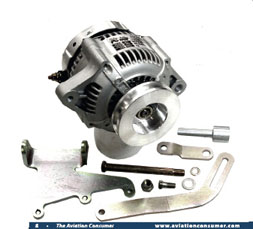
Lightweight alternators address this by producing more power at lower RPM through better efficiency than first-generation designs. They achieve this efficiency simply through improved technology; no magic tricks. Tighter tolerances, for example, between the stator and the rotor are achieved through improved manufacturing techniques.
Heat is controlled through the use of the latest materials in both heat sink and insulation. Better dynamic balancing reduces wobble friction and advances in semiconductors provide cooler, more efficient rectifiers and other circuitry. Ironically, the auto industry led the way in these improvements in its attempts to meet government guidelines for fuel-efficient automobiles.
Can you remember the last time you had an alternator failure in a car? They arent entirely unheard of, but theyre rare enough not to be of concern when you contemplate a 500-mile drive at night in driving rain and fog. Because of the inherent cost of overcoming FAA certification barriers, companies have been slow to offer improved alternator technology to the aviation segment.
Lightweight alternators were introduced to aviation in 1980 through the Experimental market by B&C Specialty Products. B&Cs Bill Bainbridge actually created an industry attacking the weight of all electrical accessories on light aircraft, including starters.
He combined resources with electrical engineer Bob Nuckolls and the two found a way to design powerful, dependable electrical components for the Experimental market, as long as the operator didnt require too much power. Gobbled up initially by aerobatic aircraft owners, these components were soon adapted to other Experimentals and installed on certified aircraft through field approvals, although that strategy wont necessarily work for every owner. (Some FSDOs will go along, some wont.)
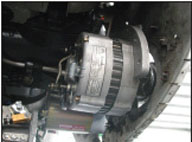
Thus far, lightweight alternators havent quite made the market inroads that starters have, but there are more providers looming on the horizon. As with old-technology starters, when one of the older, heavier alternators goes belly up, the only intelligent decision will be to replace it with something lighter and more dependable.
B&C Specialty
B
B&C introduced the BC-200G 12-amp alternator for aerobatic airplanes using both Continental and Lycoming engines. The design mounted on the vacuum pump drive gear with enough amps to run a GPS, transponder and comm radio, while still charging the aircraft battery. This was an excellent mod for engines powering the popular Rutan series of canard pushers and was later adopted by a number of certified aircraft owners. As demand grew for these and higher power alternators for larger Continental and Lycoming engines, B&C designed and produced its own line of alternators and later expanded to include a lightweight, sealed lead/acid battery.
Today, B&C offers the L-40 40-amp and L-60 60-amp belt-driven alternators in both a boss or case-mount configuration. The 200G is a gear-driven model and the SD-8 a spline-driven alternator for use on vacuum-pump pad applications.
At this point, only one of B&Cs alternators is PMAd, the L-40 for use on the Piper Super Cub. The BC-410 is certified for the Bonanza, Mooney Ovation, the Cirrus SR-20/22, Piper PA-28s and 32s and Cessna 210s as a backup in applications where vacuum pumps arent required. There’s also an STC to use the L-40 on 210s with the TKS de-icing STC.
Bainbridge has sold thousands of lightweight alternators and knows that many of these are on certified aircraft. If an owner wants to obtain a field approval, B&C has developed a system whereby the purchaser will be sent drawings and documentation, including copies of successful field approvals that will help get approval from the FAA before the alternator is actually sold. In our view, this is a must; there’s no point in buying one of the devices if the local FSDO wont bless it.
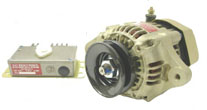
Bainbridge told us that certification for his higher output alternators is in the future. An interesting note is that B&C products are on display at the Air and Space Museum, having powered a number of record setting aircraft, such as Burt and Dick Rutans globe-circling Voyager. The company sells direct, with a couple of products available from Chief or Spruce.
In 2003, Steve Klodd and Les Staples began working on an idea that paralleled B&Cs thinking. Sky-Tek had already proven that lightweight starters were the cutting edge in light aircraft and, as with B&C, the next step was a lightweight alternator. Plane-Power took that step in September 2005, when it earned FAA certification for its first lightweight alternator.
Plane-Power is often associated with Sky-Tek, which makes the starter, but they are separate companies. You see them next to each other at all of the shows and their marketing and advertising efforts are similar. In fact, these two distinct companies are, after a fashion, best friends. They share investors and partial manufacturing and shipping facilities.
Steve Klodd, Plane-Powers president, told us that there would be more market choices in lightweight alternators if the certification costs werent so expensive. His view is that when the OEMs had access to alternators in the 1960s, they simply began installing them and certified the installation in-house under the aircraft type certificate. Since the original alternators were lighter and more dependable than generators, everyone was happy, thus research on improved products simply ceased.
When Plane-Power initiated certification, it took six months of negotiation with the FAA just to develop a test program. The result was a huge speed bump. The upside was that Plane-Power alternators are the most thoroughly tested alternators on the market, old or new. They are certified to 30,000 feet and have passed humidity, heat and vibration tests and two Experimental alternators available. The Experimental units have internal regulators, while the certified models have discrete regulators. Both versions largely share the same core, but have different mounting systems.
Some mount to a boss thats cast on Lycoming engines and others use a bracket that attaches via the front-case through bolts. Plane-Power kits include all the parts you’ll need to install the unit.
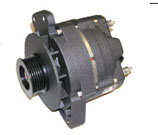
Its a direct PMA replacement, requiring merely a logbook entry. Plane-Power will soon have a 50-amp gear-driven unit for Continentals from the A-65-12 through the E-225 used on older Bonanzas and a few other production aircraft. Plane-Power offers lightweight alternators at a decent price, with a two-year, unlimited hour warranty.
Klodd told us that as of Fall 2006, the company has sold more than 1000 units with under warranty claims running we’ll under 1 percent.
National Air Parts
National has STCs to cover installations on the Cessna 310/320 and the Beech 35 series. They have a long list of field approvals and are pursuing certification of 70- and 100-amp products for application on the majority of certified airframes. All of the major parts of their kits are FAA-PMAd and their generator conversion kits use the same mounts and hardware as the originals do.
The companys basic alternator is a 70-amp unit thats actually a de-rated 100-plus amp unit. This alternator actually tests to 105 amps before shipping. All of the units are built up when ordered, so there’s inventory. They sell direct or through a handful of FBOs.
Nationals alternators arent cheap, but testimonials have praised the completeness of their kits and the reliability. Their 70-amp unit is $996.30, while the 100-amp small case replacement unit is $1696.23. The popular Beech 35 conversion kit sells for $1739. These are all list, not street prices.
Nationals most popular sellers go to Aerostars and Navajos with electric air conditioning and 100-amp upgrades. There are also upgrades for Cessna 182s, 206s and 210s.
Lamar Technologies
available the second quarter of 2007. Lamars Jim Errington told us that the company was approached by an airframe manufacturer looking for a new alternator with three requirements: 40 percent of rated power at idle; a TBO equal to the engine TBO and an electrically clean voltage signature suitable for state-of-the-art EFIS systems.
Errington reports Lamar has achieved these goals in bench and flight tests, thanks to a proprietary rectifier/diode technology. Tests have been on a variety of aircraft, including some airframe manufacturer test aircraft. With prototypes on the benches, Errington said that Lamars 40-amp units weigh 6 pounds and 60- to 80-amp alternators weigh 8.2 pounds. Theyre also producing a standard-weight alternator (11 pounds) that uses the same technology.
Lamar is expecting to warranty the new alternators to engine TBO, or a minimum of two years, but the ultimate warranty hasnt been decided yet. Likewise, prices are as yet undetermined. Non-certified versions of the lightweight alternators will be available around the first of the year and the non-certified standard size starter is available now.
The largest company in the lightweight alternator business is Kelly Aerospace. This Montgomery, Alabama-based company is preparing to enter the market with its own family of clean-sheet design lightweight alternators. Rick Quave, director of engineering at Kelly, says the company is poised to introduce two families of alternators, the ES-60 and the ES-100, each available as either 12- or 24-volt. PMA is expected by the end of the year.
Kelly already has a couple of their new units certified on OEM products, the TCM IO-240-B engine and as the standby alternator on the Columbia and the Cirrus, both using IO-550 engines. Mooney and Cirrus are using Kellys ES100/24, as approved on the TCM IO-550 type certificate.
Kellys alternators have taken a while to make it to market. Quave told us that Kelly started with a clean slate and that every component is made exclusively for their alternators. Foundries have the tooling for cases and the circuitry is built at Kellys Montgomery Power Systems Group. Nothing found in the alternators is built beyond the direct control of Kelly, guaranteeing all aspects of casting, machining, assembly and FAR compliance.
Similar to the new E-drive starter the company recently introduced, the alternators are considered “electronic” in that new circuitry is able to predict loads and failures and take itself offline and restart when a situation has corrected itself. The alternators are regulated and voltage protected externally by components manufactured by Kelly. This electronic technology guarantees a clean signal for modern avionics, which are sensitive to noisy voltage sources.
The new alternators will weigh 8 pounds less than OEM alternators and the 100-amp belt-driven units will weigh 6 pounds less. Quave says that owners can use these alternators to create a two-unit redundant system that will weigh just 25 percent more than the typical conventional alternator. This opens up the possibility of converting an older aircraft to near all-electric power. As of press time, no prices are available. On the drawing board is a 140-amp unit, as we’ll as a permanent magnet, brushless alternator.
ConclusionWhile there’s an assortment of certified lightweight starters on the market, were just beginning to see new technology alternators. The most creative and dependable, based on use and history, seem to be the as-yet uncertified B&C products. This is a philosophical choice by the companys owner. However, market pressures for certified products are moving the company towards certification.
National AirParts is essentially in the same place, with PMA units STCd on a limited number of models. Theyre a serious company, offering high output models and sophisticated and complete installation kits.
Plane-Power is the one company thats currently offering a number of certified, ready-to-go lightweight alternators and will no doubt have huge success in the market based on their business model being similar to that of Sky-Tek. Plane-Powers units appear to be both attractive dollar-wise and readily available through a number of sources, all scrambling for the lowest street price. Although they lack the sophisticated over-voltage protection of B&Cs products, theyre more affordable and easier to install in a certified airplane.
Industry giants Lamar and Kelly are offering a limited selection of lightweight alternators for the moment. But both have developed what they consider new alternator technologies and each is focusing on integrating with the electrical requirements of glass panels.
What to do at this point? We think the technology is far enough along to say that an owner would be ill-advised to replace an older Ford, Chrysler, Motorola or Prestolite-type alternator with a rebuilt unit of the same design when the option of using one of these new products exist. In addition to being lighter, theyre also more durable and reliable. Yes, they may cost more, but for the additional peace of mind prior to a rainy IFR departure, we think theyre worth the extra money.
Jim Cavanagh is a freelance writer. He lives in Kingsville, Missouri.
Contacts/sources…
Aircraft Spruce and Specialty
877-477-7823
www.aircraftspruce.com
Basic Aircraft Products
706-863-4474
www.basicaircraft.com
B&C Specialty
316-283-8000
www.bandcspecialty
General Aviation Modifications
888-359-4264
www.gami.com
Kelly Aerospace
334-286-8551
http://www.kellyaerospace.com/
LamTechnologies
ar 360-651-6666
http://www.lamartech.com/
National Air Parts
386-734-3365
www.nationalairparts.com
Plane Power, LTD
877-934-5700
www.plane-power.com

